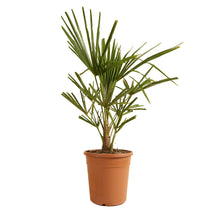Trachycarpus fortunei, commonly known as the Chinese windmill palm or Chusan palm, is a hardy and popular palm species prized for its distinctive fan-shaped leaves and ability to tolerate cooler climates. This palm features a slender, fibrous trunk topped with a crown of large, palmate leaves that are divided into numerous segments, resembling a windmill. It is a popular choice for gardens and landscapes, adding a touch of tropical elegance to temperate regions. It belongs to the Arecaceae family (the palm family).
Origin: Trachycarpus fortunei is native to central and eastern China, but it has been widely cultivated and naturalized in other parts of the world.
Light: Trachycarpus fortunei thrives in full sun to partial shade. It prefers at least 4-6 hours of direct sunlight per day, but in hotter climates, it can benefit from some afternoon shade.
Water: Water regularly, especially during dry periods. Allow the soil to dry out slightly between waterings. Avoid overwatering, which can lead to root rot.
Soil: Trachycarpus fortunei prefers well-drained soil. It can tolerate a range of soil types, but thrives in fertile, loamy soil.
Fertilising: Feed your Trachycarpus fortunei with a slow-release palm fertiliser in spring.
Temperature: Trachycarpus fortunei is one of the hardiest palms, tolerating temperatures as low as -15°C (5°F). It can be grown outdoors in many temperate regions.
Pruning: Remove any dead or damaged fronds as needed. Avoid excessive pruning, as this can weaken the plant.
Growth Habit: Trachycarpus fortunei is a slow-growing palm that can eventually reach a height of 10-12 meters (33-40 feet), but it takes many years to do so.
Uses: Trachycarpus fortunei is primarily grown as an ornamental plant. Its fibrous trunk can also be used to make rope and other materials.
Toxicity: Trachycarpus fortunei is not known to be toxic to humans or pets.





